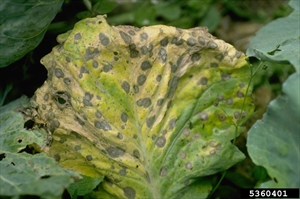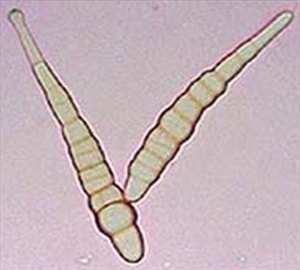Cabbage grey leaf spot
Pacific Pests, Pathogens, Weeds & Pesticides - Online edition
Pacific Pests, Pathogens, Weeds & Pesticides
Cabbage grey leaf spot (310)
Alternaria brassicae. Another Alternaria fungus, Alternaria brassicicola, cabbage black leaf spot, also occurs, and causes similar symptoms (see Fact Sheet no. 133). Microscopic examination of the spores is needed to distinguish between the two species (Photo 4).
Asia, Africa, North, South and Central America, Europe, Oceania. It is recorded from Australia, Guam, New Caledonia, New Zealand, Niue, Palau, Papua New Guinea, Vanuatu, and Wallis & Futuna.
Members of the brassica family, e.g., broccoli, cabbage, cauliflower, mustard, oilseed rape, and cruciferous weeds. Chinese cabbages and mustards are especially susceptible to Alternaria brassicae.
Grey leaf spots, circular or irregular, and mostly between the veins, occur on the leaves (Photo 2). The spots, up to 25 mm diameter, show concentric rings, giving a target-like appearance. The spots have a well-defined margin surrounded by a halo (Photo 1); and they are usually lighter than those caused by Alternaria brassicicola. Spore masses form on the lower leaf surfaces. As spots age, they become papery, and the centres fall out giving a 'shot-hole' appearance. Under favourable conditions (wet and warm, 20-30°C), the spots merge, causing the leaf to dry out and look scorched. Spots also develop on stems, leaf and flower stalks, and on seed heads. Dark, sunken rots occur on the heads of broccoli and cauliflower.
Spread of the fungus over short distances occurs in water droplets splashed from infected plants to those nearby; further spread occurs in wind-driven rain, and in wind alone when the crop is harvested. Spread over long distances occurs on seed.
A fungus is the cause of the leaf spot. It is an important disease, causing economic loss in several different ways. Its effect on seed is twofold: (i) seed infection causes both pre- and post-emergence damping-off (see Fact Sheet no. 47) leading to stem cankers of the survivors; and (ii) seed infection also affects the amount of seed harvested and its quality. On mature plants, the spots on the head and/or outer leaves are unsightly and reduce market price, as well as the time that cabbages and related crops can be stored.
Look for the brown or grey leaf spots with concentric black rings - the target spot appearance is characteristic of this disease. Look with a x10 lens to see the velvety appearance of the spots on the lower surface of the leaf where the spores form. Look to see the "shot-holes" as the centres of the spots dry and fall away. But note that microscopic examination of the spores is needed to separate Alternaria brassicae (Photo XYZ) from Alternaria brassicicola (see Fact Sheet no. 133; Photo XYZ). Symptoms alone are not enough.
CULTURAL CONTROL
Before planting:
-
Treat seeds with hot water at 50°C for 25-30 minutes, and then dry them.
-
Grow seedlings in soilless or pasteurized media in clean trays. Check regularly for signs of disease, and discard any plants with symptoms.
During growth:
-
Plant cabbages apart so that air can circulate between them; this will help to dry the leaves and reduce the time that spores have to germinate and infect.
-
Remove weeds from in and around the plots of cabbages (and related crops).
-
Avoid overhead irrigation, especially from the time leaves start to show infections.
After harvest:
-
Remove the remains of the crop after harvest, and destroy. Note, infections on the leaves produce spores until the leaves are completely decomposed. Alternatively, plough in the remains as deeply as possible.
-
Rotate crops, leaving a 1-2-year interval between crops of cabbages (and related crops) planted on the same land.
CHEMICAL CONTROL
-
Seed treatment: Iprodione has been used as a seed treatment. Captan, or thiram can be used as alternatives.
-
In the field: Fungicides used against Alternaria leaf spot include chlorothalonil, copper formulations, mancozeb, iprodione and members of the strobilurin group.
____________________
When using a pesticide, always wear protective clothing and follow the instructions on the product label, such as dosage, timing of application, and pre-harvest interval. Recommendations will vary with the crop and system of cultivation. Expert advice on the most appropriate pesticides to use should always be sought from local agricultural authorities.
AUTHOR Grahame Jackson and Eric McKenzie
Information from Diseases of vegetable crops in Australia (2010). Editors, Denis Persley, et al. CSIRO Publishing; and Gerlach WWP (1988) Plant diseases of Western Samoa. Samoan German Crop Protection Project, Deutsche Gesellschaft für Technische Zusammenarbeit (GTZ) Gmbh, Germany; and (including Photo 4) Eric McKenzie (2013) Alternaria brassicae: PaDIL - (http://www.padil.gov.au). Photo 1 Gerald Holmes, California Polytechnic State University at San Luis Obispo, Bugwood.org. Photo 2 Yuan-Min Shen, Taichung District Agricultural Research and Extension Station, Bugwood.org. Photo 3 Howard F. Schwartz, Colorado State University, Bugwood.org.
Produced with support from the Australian Centre for International Agricultural Research under project PC/2010/090: Strengthening integrated crop management research in the Pacific Islands in support of sustainable intensification of high-value crop production, implemented by the University of Queensland and the Secretariat of the Pacific Community.







